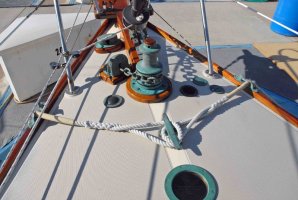For grins I may do a test with my primary sheet winches and see just how bad it would be using a manual winch to raise the tackle. As I mentioned in a previous post, I could never see using my primary winches as a permanent solution because it would leave a mess of line in the cockpit which would then have to be stowed in the anchor locker on the bow--an additional hassle I don't want. But I could certainly try it once just to see how well the winches themselves work for this application.
Maybe I'll do this on Sunday when I pull up anchor to depart the Isthmus. If I do, I'll report back!
Ok, so I did go to the Isthmus on Thursday, anchored, and returned on Sunday. And I did lead the line to my port cockpit winch to see how it worked as a manual windlass. The short answer: it sucked.
For those who enjoy the details: I was anchored in 115' of water and had out 375' of 1/2" line and about 25' of 1/4" chain. There was a slight offshore breeze, perhaps 8 knots or so. My test consisted of winching the boat in until I had out about 120' of line. (I did not use the winch for breaking out the anchor because I use the boat's own motion to do that.) After winching the boat to where I had out 120' of line, I then transferred the pile of line in my cockpit back to the anchor locker, led the line off the winch and back to the bow, and then pulled up the anchor manually as usual, after letting the boat break it out of the bottom.
I found that it took me about 18-19 minutes to crank the boat in against the wind. This is working at a reasonable pace and taking short breaks as I went. While not exhausting, I still found it strenuous and not enough of an improvement over just pulling it in by hand to bother with. And definitely slower. So I am crossing off my list the possibility of mounting a large self-tailing winch on my foredeck.
On the other hand, I must admit that the process was not a total failure and that the test I gave it was something of a worst case scenario. For one thing, I was pulling the stern into the wind and off at an angle, whereas a winch mounted on the bow would pull the boat straight ahead and would present less resistance. Second, my cockpit winches are Lewmar 30ST, which are absolutely terrific as sheet winches for an E26 but may be on the small side for this application. Third, my winch handle was your typical 8 or 10" handle; a longer one would have provided more leverage. Fourth, there were some good things about the process, most notably the fact that I could immediately stop for a break and the self tailer held everything in place, so that I didn't lose any ground. So it was not a complete failure. I just don't think that I'd be satisfied with this as a permanent solution.
At this point I'm thinking that if I'm going to mess with installing something at all, I'll go with a good sized electric windlass, oversized so I can get away with using it to pull the boat up to the anchor in a breeze. (This will typically be necessary because of how often I single hand.)
Another reason for going to with a windlass vs. my manual "armstrong" method is that, although at this point I can still manage the 40+ pounds of anchor and chain, even hauling it up 125', about every third or fourth anchoring event Neptune decides to bequeath me some kind of parting gift for my trouble. This time, after the anchor broke free and as I was lifting it I noticed that it seemed especially heavy. When it got to the surface I had a veritable kelp forest attached, including some kind of large ball of roots.




